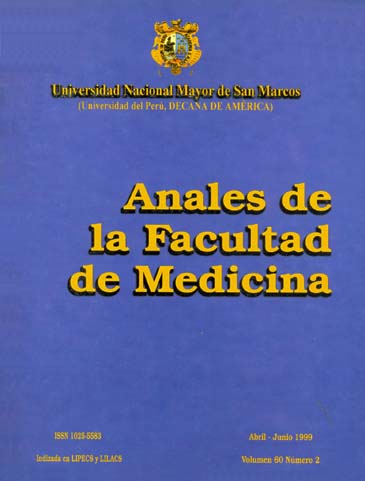Determination of Firing Distance by Gunpowder Residue Concentration Analysis
DOI:
https://doi.org/10.15381/anales.v60i2.4474Keywords:
Forensic Medicine, Wounds, Gunshot, StabAbstract
OBJECTIVE: To assess an appropriate diagnostic method by measurements of the gunpowder amount around the entrance hole on the skin. METHODOLOGY: Using a caliber-38 revolver with FAME bullets, and from pre-established distances, five series of gunshots were performed on clothed fragments of pigskin. Then, we verified the presence of gunpowder tattoos, both, over the skin and clothes. To determine the amount of gunpowder particles present on the skin, microphotografies of the specimens were taken. All firing distances drew a clean zone (peripheral to the bullet entrance hole); followed by the gunpowder tattoo, which were divided into three concentric areas. These areas are closely related to the firing distance and inversely related to the concentration of gunpowder particles. CONCLUSION: It´s possible to make an accurate asessment of firing distance (range: 30 to 100 cm), through the measurement of gunpowder residues around the entrance hole on the skin, as showed in microphotographies. We propose the term "target-like tattoo" for these skin images.Downloads
Published
1999-06-14
Issue
Section
Trabajos originales
License
Copyright (c) 1999 Rosa Carrera Palao, José Raez, Marco Villacorta, Andrés Chavieri, Judith Maguiña

This work is licensed under a Creative Commons Attribution-NonCommercial-ShareAlike 4.0 International License.
Those authors who have publications with this magazine accept the following terms:
- Authors will retain their copyrights and guarantee the journal the right of first publication of their work, which will be simultaneously subject to Creative Commons Attribution License that allows third parties to share the work as long as its author and its first publication this magazine are indicated.
- Authors may adopt other non-exclusive licensing agreements for the distribution of the version of the published work (eg, deposit it in an institutional electronic file or publish it in a monographic volume) provided that the initial publication in this magazine is indicated.
- Authors are allowed and recommended to disseminate their work over the Internet (eg: in institutional telematic archives or on their website) before and during the submission process, which It can produce interesting exchanges and increase quotes from the published work. (See El efecto del acceso abierto ).
How to Cite
1.
Carrera Palao R, Raez J, Villacorta M, Chavieri A, Maguiña J. Determination of Firing Distance by Gunpowder Residue Concentration Analysis. An Fac med [Internet]. 1999 Jun. 14 [cited 2024 Jul. 17];60(2):102-9. Available from: https://revistasinvestigacion.unmsm.edu.pe/index.php/anales/article/view/4474















